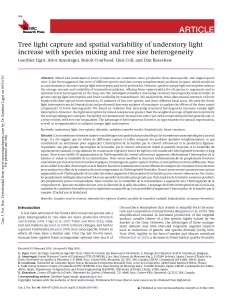Ligot G., Ameztegui A., Courbaud B., Coll L., Kneeshaw D.
Mixed and multi-layered forest ecosystems are sometimes more productive than monospecific and single-layered ones. It has been suggested that trees of different species and sizes occupy complementary positions in space, which would act as a mechanism to increase canopy light interception and wood production. However, greater canopy light interception reduces the average amount and variability of transmitted radiation, offering fewer opportunities for all species to regenerate and to maintain forest heterogeneity in the long run. We investigated whether increasing overstory heterogeneity indeed results in greater canopy light interception and lower variability in transmittance. We modeled the three-dimensional structure of forest stands with three typical forest structures, 10 mixtures of four tree species, and three different basal areas. We used the forest light interception model SAMSARALIGHT and performed three-way analyses of covariance to analyze the effects of the three varied components of forest heterogeneity. We found no evidence that increasing structural heterogeneity increases canopy light interception. However, the light interception by mixed canopies was greater than the weighted average of light interception by the corresponding pure canopies. Variability in transmittance increased in some cases with compositional heterogeneity and, to a lesser extent, with tree size inequalities. The advantage of heterogeneous forests is in opportunities for natural regeneration, as well as in opportunities to enhance canopy light interception.
Consultez la notice complète de l’article sur ORBi

